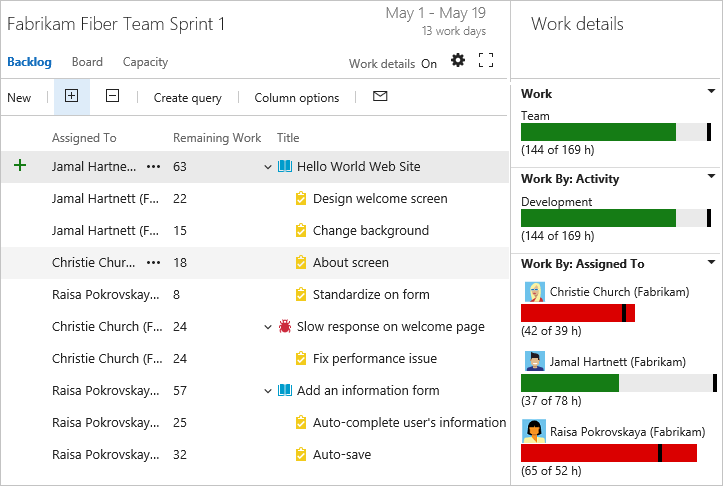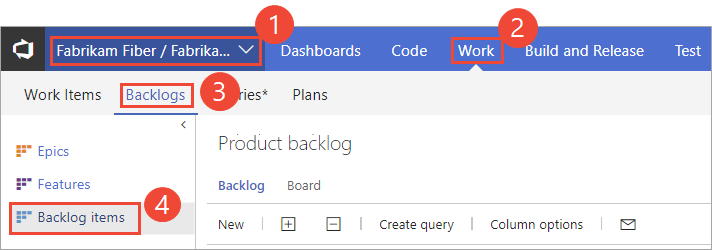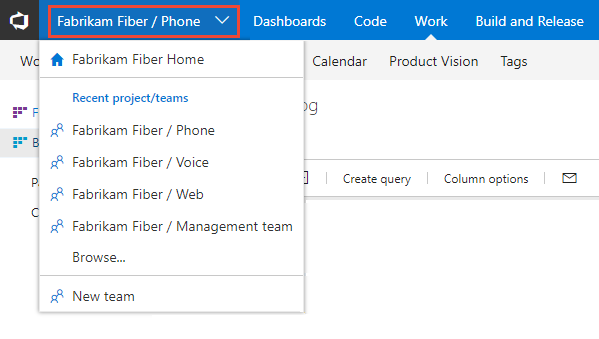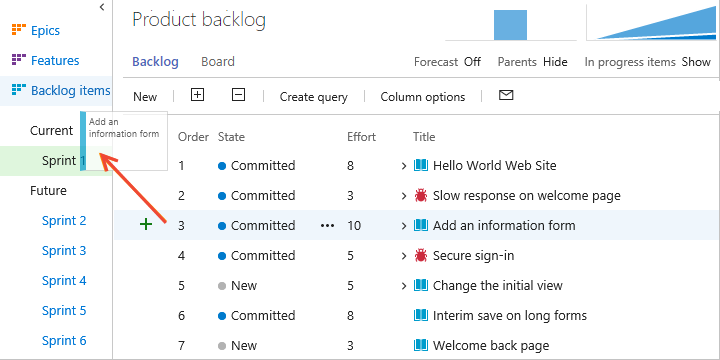1. Assign backlog items to a sprint in Azure Boards
TFS 2018
The first step in planning your sprint is to assign work from your backlog to a sprint. Your team builds the sprint backlog during the sprint planning meeting, typically held on the first day of the sprint. Each sprint corresponds to a time-boxed interval that supports your team's ability to work using Agile processes and tools. During the planning meeting, your product owner works with your team to identify those stories or backlog items to complete in the sprint.
Note
Your project comes with several predefined sprints. You can quickly add more sprints from your backlog as needed. Or, change the dates of the predefined sprints. To learn more about sprints, also referred to as iterations, see About areas and iterations.
Here's an example of a sprint plan that consists of backlog items and the tasks required to complete each item. By setting team capacity and estimating tasks, the team can see when the team or a team member is at, under, or over capacity.

In this article you'll learn how to:
- Open your product backlog
- Assign backlog items to a sprint
- Use multi-select to bulk update work items
Planning meetings typically consist of two parts. In the first part, the team and product owner identify the backlog items that the team feels it can commit to completing in the sprint, based on experience with previous sprints. These items get added to the sprint backlog. In the second part, your team determines how it develops and tests each item. They then define and estimate the tasks required to complete each item. Finally, your team commits to implementing some or all of the items based on these estimates.
Note
Sprint planning doesn't need to be challenging. It can be fun and a time for the entire Scrum team to build camaraderie by working together to answer the question of "What can we commit to?" For examples and strategies to keep your sprint planning focused and effective, check out the What is Scrum?.
When you've completed your sprint plan, your sprint backlog should contain all the information your team needs to successfully complete work within the time allotted without having to rush at the end.
Prerequisites
When you create a project or a team, backlogs get created automatically. Each team has access to their own product, portfolio, and sprint backlogs.
| Prerequisite | Description |
|---|---|
| Project Administrator or Contributor member | You must be added to a project as a member of the Contributors or Project Administrators security group. |
| Stakeholder access | To add or modify work items, you must be granted Stakeholder access or higher. |
| Contributor member or Allow perms on | To view or modify work items, you must have your View work items in this node and Edit work items in this node permissions set to Allow. By default, the Contributors group has this permission set to Allow. For more information, see Set permissions and access for work tracking. |
| Defined iterations | To use the Planning pane, your team administrator must define iteration (sprint) paths and configure team iterations. |
Open your team's product backlog
Note
Your sprint backlogs are one of three classes of backlogs available to you. For an overview of the features supported on each backlog and the two types of boards, see Backlogs, boards, and plans.
For a beginner's guide to planning and tracking work, see Get started with Agile tools.
From your web browser, open your team's product backlog. (1) Select the team from the project/team selector, choose (2) Work, (3) Backlogs, and then (4) the product backlog, which is Backlog items (for Scrum), Stories (for Agile), or Requirements (for CMMI).

To choose another team, open the project/team selector and select a different team or choose the Browse option.

The set of sprints selected for your team appears in the left pane. If you don't see any sprints listed, you can add sprints or select existing sprints for your team's use. To learn how, see Define sprints.
(Optional) To choose which columns should display and in what order, choose Column options. You may want to add the Iteration Path to the set of columns that appear on your backlog. For more information, see Change column options.
Assign work from your backlog to a sprint
Before you start planning your sprint, you'll want to have created, organized, and estimated your backlog.
Also, you'll want to have set the start and end dates for your sprint.
You can quickly assign work items to a sprint through drag-and-drop from the product backlog to the sprint.
Select one or more items and drag them to one of the listed sprints.
Note
The Iteration Paths listed only show the current sprint and the next 10 future sprints in the list, even if more have been selected for the team. Only a team administrator or member of the Project Administrators group can select iterations for a team.

Use the multi-select feature to modify items in bulk
Multi-select of work items on the product and sprint backlogs works in the same way as multi-select works within query results.
With multi-select, you can complete several actions on several work items at once, such as:
- Move to a sprint
- Change the backlog priority
- Assign to a team member
- Change one or more field values
- Add links
- Map items or change the parent an item is linked to
To select several items in a sequence, hold down the shift key. To select several non-sequential items, use the Ctrl key. Then, you can either drag the selected items to a new position within the backlog, to a different sprint, or select an option from the context (![]() ) or action (
) or action ( ![]() ) menu of one of the items.
) menu of one of the items.
For more information, see Bulk modify work items.
Next step
Now that you've defined your sprint plan, your team's ready to begin work on the sprint tasks.
Related articles
To add or rename the sprints your team uses, see Define iteration (sprint) paths and configure team iterations.
If your backlog doesn't show the work items you expect, see Setup your Backlogs & Boards.